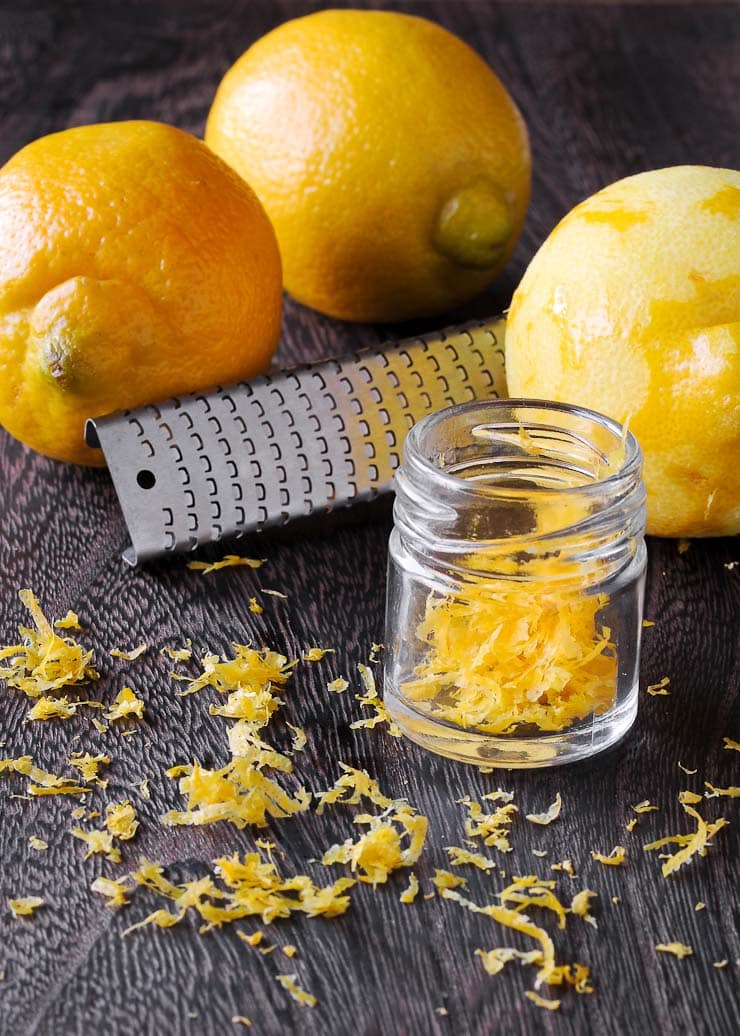What exactly is a fresh lemon zest and how do you make it work with the microplane grater? In this post I will show you the easiest way to zest the lemon and how to preserve fresh lemon peel. Add lots of rich flavor to your sweet and savory recipes by making the most out of your lemon peels!

What is Lemon Zest?
Fresh lemon zest comes from the bright yellow portion of the rind. It’s colorful, flavorful and has citrusy aroma because the fruit’s essential oils reside in its rind. Lemon zest is quick and easiest way to add tons of flavor to many recipes.
I also love to zest oranges, limes and grapefruits. Zesting any citrus fruit is practical, easy and simple.
Why Zest a lemon (or any citrus fruit)?
- I love using lemon zest in baking. It’s extremely versatile and is appropriate for a variety of desserts. Besides, zesting is one of the best ways to harness all of the sharp citrusy flavor of the lemon. Much more flavor that you will ever get from juicing. When you want to add a zingy, sweet citrus flavor to a dessert, the zest is the way to go. As I mentioned earlier, it has natural oils that will impart amazing flavor to many dishes.
- Use zest in salads or marinades. Sometimes all you need is just a little bit to make a huge difference.
- Freshly grated zest can also be used as decoration on iced breads, cakes, and cupcakes.
How to Choose a Lemon
- First of all we need to choose the right kind of lemons. Be sure to use organic lemons as much as possible. Since non-organic lemons might be coated with questionable protective layer, going organic is the safest bet. Always wash and dry the fruit before using the zester.
- If using non-organic lemons, remove the wax coating first. It’s very easy to do! Simply put the fruit in a colander and pour over water from a recently boiled kettle or rinse the fruit under a hot running tap (if you trust your tap water). Then, scrub the fruit all over with a stiff brush, such as a vegetable brush, under a cool running tap but try not to use a brush or scrubbing sponge that you use for dishes as this could cause some soap residue to get on to the fruit. Rinse the fruit thoroughly with cold water and leave to dry, or dry with paper towels.
Easy Way to Zest a Lemon
- The easiest way to zest a lemon is with a help of a microplane zester. You can also use a knife, cheese grater or vegetable peeler.
- Always zest a whole lemon! You do not want to to zest 4 tiny wedges of lemon. Zest an entire citrus.
- While zesting, be sure to avoid the white bitter layer separating the colorful zest and the fruit.
Does wax on a citrus fruit make it unsafe to zest?
Citrus fruit have a natural wax coating that is washed off along with orchard grime at the packing house. A new protective coating is usually applied before packing. This protects the fruit in transit, makes it look shiny, slows down moisture loss and extends shelf-life.
Unfortunately, both natural waxes and petroleum-based waxes are used. To prevent ingesting the unwanted waxes, opt for organic lemons and make sure to remove the wax coating from the citrus fruit before zesting.
Remember that not all unwaxed lemons are organic, but all organic ones are unwaxed. A new, olive oil-based wax suitable for organic fruit is in development, but not yet in use.
How to preserve lemon peel
Lemon peel stores beautifully in small jars in the refrigerator for up to 2 weeks. Because lemon zest is so compact, I recommend using a tiny jar to preserve space in the fridge.
How to freeze citrus zest
- Place the zest in a single layer on a piece of parchment paper.
- Move it to the freezer. Once frozen, transfer the zest to a zip-top plastic bag.
- I usually label it with the date and type of citrus zest.
- Store it in the freezer for up to six months.
How to use frozen zest
I never thaw the zest prior to use. Since it’s frozen, it will retain the fresh flavor that it originally had. This means that I can use it in exactly the same way as I would fresh zest. I like to overmeasure frozen zest slightly to compensate for any ice crystals. For example, when a recipe calls for 1 teaspoon of fresh lemon zest, I measure out 1 ½ teaspoons of frozen zest.
Recipes with Lemon Zest
Baked Cajun Salmon
Berry Bundt Cake with Lemon Glaze
How to cook spinach
How to zest a lemon with a lemon zester
Ingredients
- 1 tablespoon lemon zest
Instructions
- Zest a lemon using a microplane zester. Store in a glass bottle, or freeze in a air tight ziplock bag.
Nutritional information is provided as a courtesy only. This information comes from online calculators. Although whatsinthepan.com attempts to provide accurate nutritional information, these figures are only estimates.


My family and I love cheese. We try not to eat it too often, but when we do, we like to enjoy quality cheese! I have never considered buying a new cheese grater until now. Thank you for the article!
Hi Cristi – I like when things take such unexpected turn:). Glad the cheese grater is on your radar right now!
Thanks for making this simple clear post! I was given some organic lemons and my first thought was to zest them before juicing them. I did not know organic lemons made their own wax!
The power of nature!
As my hands age I found that a “kitchen specific” NEW Ped-Egg is helpful (brand name seems better than the Dr Scholl brand). I zuzz it back and forth which means the catchment base has fine zest and if I do a lot it rolls into little balls, so I just whir it with the sugar the recipe requires. Other methods hurt my hands. Maybe this idea will help someone else
Many thanks for the info I was looking for. I had no idea lemons had wax on them.
Thanks for lots of good info. I have been wasting peels that I could put to good use. You have inspired me to change my habits.